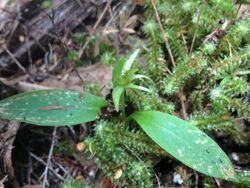Biology:Chiloglottis cornuta
| Green bird orchid | |
|---|---|

| |
| Scientific classification Error creating thumbnail: Unable to save thumbnail to destination
| |
| Kingdom: | Plantae |
| Clade: | Tracheophytes |
| Clade: | Angiosperms |
| Clade: | Monocots |
| Order: | Asparagales |
| Family: | Orchidaceae |
| Subfamily: | Orchidoideae |
| Tribe: | Diurideae |
| Genus: | Chiloglottis |
| Species: | C. cornuta
|
| Binomial name | |
| Chiloglottis cornuta Hook.f.[1]
| |
| Synonyms[1] | |
| |
Chiloglottis cornuta, commonly known as the green bird orchid,[2] is a species of orchid found in south-eastern Australia and in New Zealand, including many of its offshore islands. It has two broad leaves and a single green or pinkish flower with six to eight rounded, flattened green, reddish or blackish calli on the labellum.
Description
Chiloglottis cornuta is a terrestrial, perennial, deciduous, herb with two elliptic leaves 60–100 mm (2–4 in) long and 20–30 mm (0.8–1 in) wide on a petiole 5–10 mm (0.2–0.4 in) long. A single green to reddish flower 13–16 mm (0.5–0.6 in) long and 25–30 mm (0.98–1.2 in) wide is borne on a flowering stem 40–100 mm (2–4 in) high. The dorsal sepal is lance-shaped to egg-shaped, 13–16 mm (0.5–0.6 in) long and 5–7 mm (0.2–0.3 in) wide. The lateral sepals are 10–12 mm (0.4–0.5 in) long, about 3 mm (0.1 in) wide and curve forwards. There is a glandular tip about 1 mm (0.04 in) long on the sepals. The petals are linear to lance-shaped, 10–12 mm (0.4–0.5 in) long, about 3.5 mm (0.1 in) wide and spread widely apart from each other. The labellum is heart-shaped, 9–12 mm (0.4–0.5 in) long and 7–8 mm (0.28–0.31 in) wide with six to eight rounded dark red, green, reddish or blackish calli. The column is erect, almost as long as the dorsal sepal with broad wings on the upper half. Flowering occurs from November to February.[2][3][4][5]
Taxonomy and naming
Chiloglottis cornuta was first formally described in 1844 by Joseph Dalton Hooker from a specimen collected near "Campbell's Island" and the description was published in Flora Antarctica.[6][7] The specific epithet (cornuta) is a Latin word meaning "bearing horns".[8]
Distribution and habitat
The green bird orchid grows in moist places in sheltered forest in far south-eastern New South Wales, eastern Victoria, far south-eastern South Australia and in Tasmania. In New Zealand it occurs on both the North and South Islands and on Stewart, Chatham, the Antipodes, Campbell and Auckland Islands.[2][3][4][5][9]
References
- ↑ 1.0 1.1 "Chiloglottis cornuta". World Checklist of Selected Plant Families (WCSP). Royal Botanic Gardens, Kew. http://wcsp.science.kew.org/namedetail.do?name_id=38968.
- ↑ 2.0 2.1 2.2 Jones, David L. (2006). A complete guide to native orchids of Australia including the island territories. Frenchs Forest, N.S.W.: New Holland. p. 143. ISBN 1877069124.
- ↑ 3.0 3.1 Jones, David L.. "Chiloglottis cornuta". Royal Botanic Garden Sydney. http://plantnet.rbgsyd.nsw.gov.au/cgi-bin/NSWfl.pl?page=nswfl&lvl=sp&name=Chiloglottis~cornuta. Retrieved 20 April 2018.
- ↑ 4.0 4.1 Jeanes, Jeff. "Chiloglottis cornuta". Royal Botanic Gardens Victoria. https://vicflora.rbg.vic.gov.au/flora/taxon/d97fc1ad-47e3-4945-9e79-0cf6fab9c8a4. Retrieved 20 April 2018.
- ↑ 5.0 5.1 de Lange, Peter J.. "Chiloglottis cornuta". New Zealand Plant Conservation Network. http://www.nzpcn.org.nz/flora_details.aspx?ID=2260. Retrieved 20 April 2018.
- ↑ "Chiloglottis cornuta". APNI. https://id.biodiversity.org.au/instance/apni/471504. Retrieved 20 April 2018.
- ↑ Hooker, Joseph Dalton (1844). The botany of the Antarctic voyage of H.M. discovery ships Erebus and Terror. I. Flora Antarctica. London: Reeve Brothers. p. 69. https://www.biodiversitylibrary.org/item/22023#page/91/mode/1up. Retrieved 20 April 2018.
- ↑ Brown, Roland Wilbur (1956). The Composition of Scientific Words. Washington, D.C.: Smithsonian Institution Press. p. 421.
- ↑ "Chiloglottis cornuta". State Herbarium of South Australia. http://www.flora.sa.gov.au/cgi-bin/speciesfacts_display.cgi?form=speciesfacts&family=&genus=Chiloglottis&species=cornuta&iname=&submit=Display. Retrieved 20 April 2018.
Wikidata ☰ Q15495476 entry
 |


